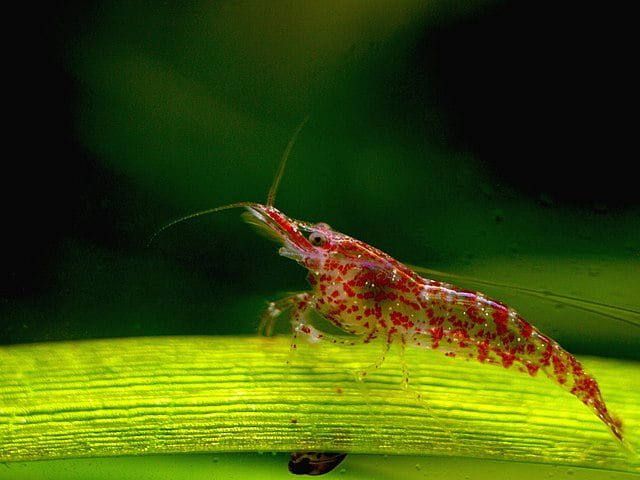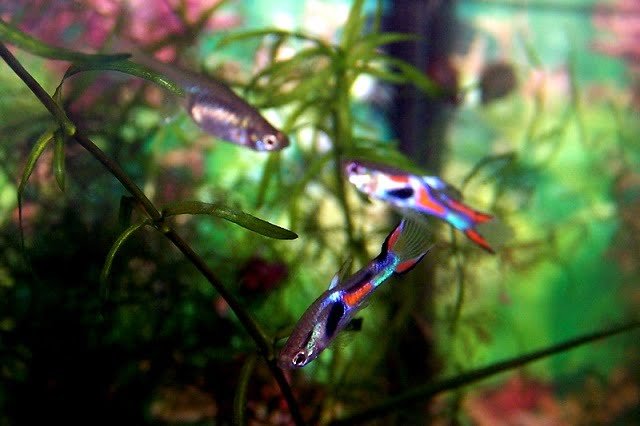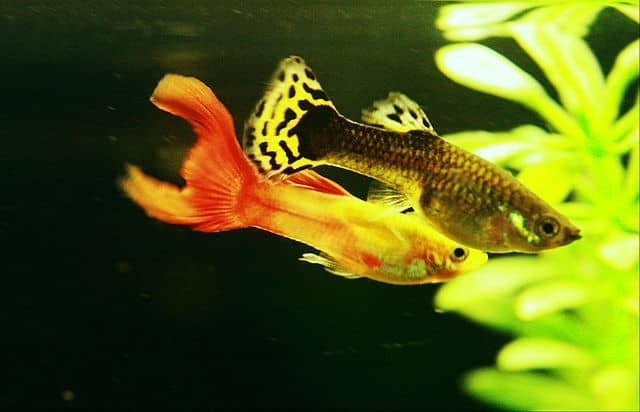
The guppy fish, also known as million fish or lebistes, are small tropical freshwater fish very popular in aquarium hobby. They are appreciated for their vibrant colors, ease of care, and rapid reproduction.
The guppy fish (Poecilia reticulata) was discovered and named in 1859 by the German zoologist Wilhelm Peter, in Venezuela. Currently, this fish has spread to many countries around the world.
In some countries, Poecilia reticulata was introduced accidentally, while in others, it was introduced to control mosquitoes, as guppies consume mosquito larvae, making them a cheap option for reducing mosquito populations (Sheppard, 2021). However, releases into natural water bodies have turned guppy fish into competitors with native fish.
Today, guppy fish are used in scientific research and are also available in physical and online ornamental fish stores, with prices ranging from US$4 to 25 per specimen, depending on their rarity and uniqueness.
This article aims to provide you with updated information on breeding, reproduction, feeding, and care for your guppy fish.
Taxonomy of guppy fish
Kingdom: Animalia
Phylum: Chordata
Class: Actinopterygii
Order: Cyprinodontiformes
Family: Poeciliidae
Genus: Poecilia
Scientific name: Poecilia reticulata
Common names: Guppy, gupis, guppys, lebistes (Argentina and Uruguay) or million fish (Trinidad).
According to Lyons (2021), Poecilia reticulata is native to northeastern South America (Antigua and Barbuda, Barbados, Guyana, Suriname, Trinidad and Tobago, and Venezuela); however, due to its use as a mosquito controller and in the ornamental industry, it has been introduced to other Latin American countries, North America, Africa, and Europe.
Morphology of guppy fish
Guppy fish exhibit sexual dimorphism, making it easy to distinguish males from females by coloration, fin shape, or size. Male guppies can reach a length of 3 to 4 cm, while female guppies grow up to 6 cm.
Stay Always Informed
Join our communities to instantly receive the most important news, reports, and analysis from the aquaculture industry.
On the other hand, researchers report that the lifespan of guppies is 2 years in the wild; while in aquariums, they can live up to 5 years.
Males tend to be smaller and have more vibrant colors, while females have a brownish coloration and are larger and rounder (Sanders, 2018).
Female guppy fish
Female guppies have a size of 6 to 8 centimeters, they are bulky, and have an opaque coloration.
In captive-bred species selected for aquariums, the caudal fin of females has a more intense coloration.

Male Guppy Fish
Males are smaller in size, measuring from 3 to 4 centimeters; however, unlike females, they exhibit a greater variety of colors.
Additionally, the caudal fin of male guppy fish can end in different shapes: pointed, shovel-shaped, crown-shaped, etc., which gives the name to the different guppy varieties.
The main characteristic of male guppies is a modification of the anal fin called the gonopodium, which is their sexual organ, located at the back of the fish.

Types of Guppy Fish
Sheppard (2021) reports that there are over 300 types of guppy fish; because these ornamental fish exhibit a spectrum of colors and patterns that have been developed through selective breeding.
Types of guppy fish can be classified according to tail type, color, and eye color.
Guppy fish by tail type
Some common types of guppy fish are fan tails, flag tails, round tails, needle tails, and veil tails. Additionally, some fish have long, flowing tails, while others have short, flat tails.

Guppy fish by color type
Most guppies are two or three-toned, with colors including red, orange, black, yellow, green, pink, purple, silver, and blue. Spots and stripes are patterns that can be found on the body, fins, and tail of the guppy fish.

Classification of guppy fish by characteristics
There are numerous varieties of guppies, products of selective breeding. Some of the most popular ones are:
- Endler Guppy: Often confused with common Guppies, Endler Guppies (Poecilia wingei) are a separate species found in the same areas of South America. They are smaller than common Guppies and are distinguished by their bright colors and striking patterns.

- Cobra Guppy: Cobra Guppies are recognized for their color patterns, which often resemble those of a cobra snake. These patterns can range from thin stripes to wide spots, creating a unique appearance that attracts attention.
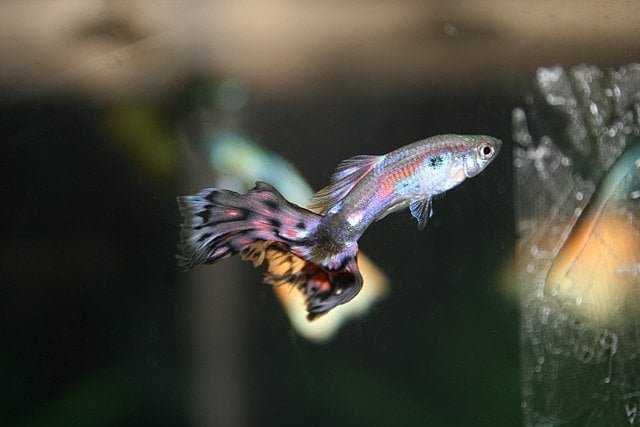
- Dumbo Guppy: With long and prominent pectoral fins.
- Mosaic Guppy: These Guppies are known for their vibrant fins that appear adorned with a mosaic pattern. They can have caudal, dorsal, and pectoral fins of different colors, creating a distinctive and attractive look.
Reproduction of guppy fish
Guppy fish are viviparous, they reproduce easily, and reach sexual maturity at 3 months of age. Zdanovich (2023) studied the sexual behavior of guppy fish and concluded that “temperature fluctuations experienced by fish when exposed to a temperature gradient field (24 to 28 oC) had a stimulating effect on the intensity of male courtship and the reproductive success of guppies”.
For guppy fish breeding or reproduction, experts recommend a ratio of 1 male guppy to every three female guppies. Female guppies ovulate every three days and give birth at 10 to 20 weeks of age; while males mature at 7 weeks.
On the other hand, García et al., (2023) determined that for guppy reproduction (1 male and 2 females) at least one tank with a volume of 1.0 liter of water is needed, smaller volumes affect reproduction and larval rearing.
Mating of guppies
Although reproduction in guppies is predominantly driven by female guppy choice, with them responding to elaborate male courtship; nevertheless, male guppies can also be selective and it is known that they prefer larger females.
A curious fact is reported by Houde and Endler (1990), whose research concludes that in some guppy populations, females discriminate among males based on variation in the extent of orange pigment in male color patterns.
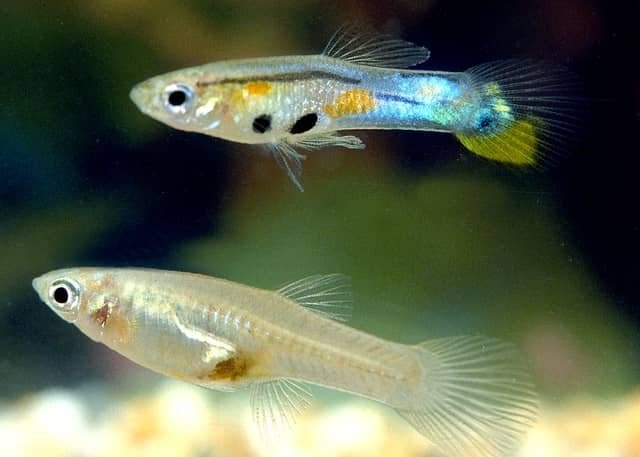
Bischoff et al (1985) highlight that female guppies show a clear preference for males with larger tails, and that female guppies also prefer guppy males with higher display rates.
When competing for mates, male guppies typically exhibit higher rates of intrasexual aggression and courtship than females (Chuard et al., 2016).
Gestation of Guppies
In the reproduction of guppy fish, Sato et al (2021) report that the gestation period in female guppies paired with “attractive” males (due to their coloration) was significantly shorter than in females paired with monotonous males.
During pregnancy, female guppies become swollen and the black spot on their belly enlarges, which is nothing but the fry developing in their womb.
The number of fish larvae depends on the size of the female guppy, with litters ranging from 3 to 100 larvae.
Female guppy fish can store sperm in sacs called spermatophores, so they can fertilize eggs for different births with a single copulation.
Breeding Guppy Fry
After birth, the fry hides in aquatic plants to avoid being eaten by other fish or by their parents.
It is recommended that once the guppy fry is born, they be separated into a separate aquarium to prevent them from being devoured, although in planted aquariums, many survive.
Mayra and Marañon (1998) reported in Poecilia reticulata, that pH is a determinant in the sex ratio; they report that basic pH (8.5 – 8.8) leads to a higher proportion of males, while an acidic pH (6.2 – 6.5) you can obtain a higher proportion of females.
Risks of inbreeding in guppy fish
Sanders (2018) warns that after breeding together many generations of the same population of guppy fish, it is possible to observe an increase in the number of guppies with congenital abnormalities, such as twisted dorsal spines.
In this regard, Smallbone (2016) tested the effects of consanguinity (breeding between siblings) on the resistance of guppy fish to infection with Gyrodactylus turnbulli, concluding that inbred individuals had a higher intensity of parasites.
In this sense, if you are dedicated to breeding guppy fish, it is advisable to have several genetic lines of guppy fish to avoid inbreeding, and therefore, the problems described above.
Feeding guppy fish
What do guppy fish eat?
Guppy fish are omnivorous fish. In their natural environment, these fish feed on algae remnants, diatoms, invertebrates, plant fragments, and insect larvae, among other food sources.
Fernando et al (2018) determined that the diet of Poecilia reticulata, in a natural environment, consists of filamentous algae, diatoms, and detritus.
In aquariums, guppy fish can be fed:
- Live foods: Artemia (brine shrimp), daphnia (water fleas), tubifex, and mosquito larvae.
- Artificial foods: flakes, pellets.
- Fresh foods: vegetables such as peas (peeled and cooked), mashes (carrot, spinach combined with chicken liver).
In the case of guppy fry, it is recommended to feed them with infusoria, Artemia nauplii, or mosquito larvae.
Likewise, food can be provided to guppy fish two or three times a day.
It is important to note that a balanced diet is key to the coloration of your fish. Arce et al (2018) evaluated the effect of live foods (Artemia nauplii, water fleas, and micro worms) and commercial flakes on the coloration of Poecilia reticulata; determining that male and female guppies were more colorful when fed live food.
Also, Champika et al (2022) reports that a diet for Poecilia reticulata fry that includes 10% powdered egg yolk, 49.6% fish meal, and 18.8% soy flour offers the best indicators in weight gain and specific growth rate.
A recent research by Seyedeh et al., (2023) concludes that supplementing the diet of P. reticulata with garlic and sweet red pepper improves immunity and coloration of male guppies.
On the other hand, Peláez et al (2021) studied the feeding behavior and food selection by guppy fish fry of four morphotypes: yellow-tailed, red-tailed, metallic blue-tailed, and black-tailed. They determined that in the fourth and fifth week, yellow-tailed and red-tailed guppies consumed a greater number of cladocerans, while larvae of metallic blue-tailed and black-tailed guppies continued to prefer rotifers up to 4 weeks.
How to care for guppy fish?
Ideal for those starting in the exciting world of aquariums, guppies require little maintenance and can tolerate some beginner mistakes (Sanders, 2021).
Guppy fish are known for their robustness and great ability to adapt to different water quality conditions; however, the fish prefer planted aquariums with abundant vegetation (Anubias sp., Java fern, flame moss, and wisteria).
Some general features you should provide for the care of guppies are:
Table 1. General characteristics for breeding guppy fish
| Parameter | Characteristics |
|---|---|
| Tank Size | From 20 liters. You should consider an additional 5 liters per guppy fish. |
| Water Temperature | Between 18 to 32 ºC, optimal 28 – 30 ºC. Lethal: >32 ºC |
| Water pH | Between 7 and 8.5, ideal 7.5 |
| Water Hardness | 10 to 25 GH |
| Aquarium Lighting | 8 – 10 hours of light. |
| Substrate | Sand, rocks, vegetation. |
| Filter | Not essential, but can be used to maintain water quality. |
| Illumination | Not necessarily, unless the aquarium has a large number of plants or no access to natural light. |
| Water Heater | Yes, to prevent fluctuations and maintain the ideal temperature. |
Kumar et al (2017), based on their research on the effect of temperature and survival in guppy fish, report that water temperature in the range of 28 to 30 °C seems to be most effective for breeding Poecilia reticulata.
Regarding fish density, experts recommend 1 guppy fish per 5 liters of water. Likewise, it is recommended to maintain more female guppies than males, because males only “think” about reproducing and if there are few females, they could end up stressing them. On the other hand, concerning the coloration of breeding tanks, Serihollo (2024) determined that the use of transparent containers can increase the growth rate, but it has an impact on the survival rate of guppies; while the brighter the breeding container, the more it will affect the feeding response and aggressiveness of the guppies.
Görelşahin et al (2018), based on their research, offer some general recommendations for guppy fish breeders for commercial purposes:
- The optimal stocking density of Poecilia reticulata in aquaculture recirculation systems up to commercial size is 3 fish/L.
- Offering tubifex three days/week as supplementary food is advantageous for accelerating growth.
- Guppies grew significantly faster in single-sex culture than in mixed cultures (females and males).
- Production in recirculating aquaculture systems provides high production per unit area and offers good prospects for breeding guppies worldwide.
An interesting fact about male guppies is that their brains grow in response to the presence of a predator, whether in the wild or in captivity; which is an advantage because it allows the fish to detect the threat and learn how to react to the predator (Reddon et al. 2018).
Fish Compatible with Guppies
Guppies are quite peaceful, although you should be careful with their tankmates, such as betta fish, because they tend to nip at the tails of guppies.
Fish compatible with guppies include platies, mollies, and tetras.
Diseases Affecting Guppy Fish
Many fish disease problems are mainly due to nutritional deficiencies. In this regard, you should consider the type of food you provide to your fish.
In this regard, Ahmadniaye et al (2020) recommend administering 0.15 mL of aqueous garlic extract per kilogram of food to achieve optimal skin mucus immunity in P. reticulata.
Bisht et al (2020) recommend using 15% moringa leaf powder (Moringa oleifera) per kilogram to significantly improve skin mucus immunity in guppies. Mucus, or slime, is the first line of defense against potential pathogens such as the fungus Saprolegnia.
Experts like Woods (2022) and Smith (2022) report several diseases affecting guppies.
Guppy Disease
Guppy disease, also called protozoan disease, is caused by parasitic protozoa called Tetrahymena sp., and usually occurs when the aquarium water quality is poor or the water temperature is not adequate.
Tetrahymena sp. attacks guppies by adhering to the fish’s outer surface and then burrows into the fish’s muscle.
Symptoms of protozoan disease include loss of appetite, breathing problems, and excess mucus.
This disease is incurable, so sick fish should be removed, to address guppy disease, the first thing to do is to improve the water conditions in the tank.
Ich or White Spot Disease
Ich is a classic parasitic disease in aquariums, affecting all freshwater fish, including guppies.
Symptoms of the disease include white spots on the bodies of fish, and fish rubbing against surfaces in the aquarium. This disease is caused by stress and poor water quality.
White spot disease is caused by the parasite Ichthyophthirius multifiliis and can be treated by quarantining affected fish and increasing the water temperature by 2 degrees, which accelerates the parasite’s life cycle.
This disease can be treated with methylene blue or dissolve a tablespoon of salt per 20 liters of water to treat the disease. Likewise, Sahandi et al., (2023) demonstrated the use of garlic (Allium sativum – 0.1 g/L of aqueous garlic extract) and chamomile (Matricaria chamomilla – 0.4 g/L of aqueous chamomile extract) to treat Ich.
Fin and Tail Rot
Guppy fish with long, loose fins are prone to fin and tail rot. This bacterial infection is caused by stress, overcrowding, and poor water quality in the tank.
Symptoms of fin rot include discolored or milky, irregular, frayed, and shortened fins.
Treatment: Perform a complete water change in the aquarium and use antibiotics recommended by a veterinarian.
Dropsey
Dropsey is incurable and is caused by the death of internal organs, which release fluids and cause a large swelling in the abdomen.
Swelling and raised scales are always present in cases of dropsey. If your guppies have these symptoms, it is best to euthanize them.
Conclusion
The guppy fish is ideal for hobbyists entering the world of aquariums, as their breeding is straightforward and requires little care. Currently, breeding guppy fish has become common in many freshwater aquariums.
Despite the robustness of guppy fish for breeding, some basic requirements must be met to respond to demand in terms of water quality and good conditions for reproduction.
References
Ahmadniaye Hamidreza, Omid Safari, Yahya Selahvarzi, Ali Baghalian, Elham Kia. Non-specific immunity promotion in response to garlic extract supplemented diets in female Guppy (Poecilia reticulata). Fish & Shellfish Immunology, Volume 97, 2020, Pages 96-99, ISSN 1050-4648,
https://doi.org/10.1016/j.fsi.2019.12.007.
Bischoff, R.J., Gould, J.L. & Rubenstein, D.I. Tail size and female choice in the guppy (Poecilia reticulata). Behav Ecol Sociobiol 17, 253–255 (1985). https://doi.org/10.1007/BF00300143
Bisht, M, Kumar, A, Shah, TK. Effect of Moringa oleifera leaf powder on skin mucosal immune responses and growth performance of guppy, Poecilia reticulata (Peter, 1860). Aquac Res. 2020; 51: 4984– 4990. https://doi.org/10.1111/are.14834
Champika Perera G. S., Ram C. Bhujel, Krishna Salin, Loc Thai Nguyen, Amonrat Sermwatanakul & Ooi Ei Lin (2022) Effect of the varying inclusion levels of the egg yolk powder on growth, stress tolerance, and pigmentation of Guppy (Poecilia reticulata), Journal of Applied Aquaculture, DOI: 10.1080/10454438.2022.2027835
Chuard Pierre J.C., Grant E. Brown, James W.A. Grant. The effects of adult sex ratio on mating competition in male and female guppies (Poecilia reticulata) in two wild populations. Behavioural Processes, Volume 129, 2016, Pages 1-10, ISSN 0376-6357, https://doi.org/10.1016/j.beproc.2016.05.001.
Deacon Amy, Hideyasu Shimadzu, Maria Dornelas, Indar W. Ramnarine & Anne E. Magurran. 2015. From species to communities: the signature of recreational use on a tropical river ecosystem. Ecology and Evolution 5 (23): 5561–5572. DOI:10.1002/ece3.1800.
Fernando, G.K.A.W., Jayakody, S., Wijenayake, W.M.H.K. et al. A comparison of the larvivorous habits of exotic Poecilia reticulata and native Aplocheilus parvus. BMC Ecol 18, 25 (2018). https://doi.org/10.1186/s12898-018-0180-1
García, L. N., & Giraldo-Gongora, P. A. (2023). The effect of aquarium size/volume on the reproduction of the guppy fish Poecilia reticulata (Peters, 1859). Aquaculture, Aquarium, Conservation & Legislation, 16(3), 1483-1487.
Görelşahin Selçuk, Mahmut Yanar, Metin Kumlu. 2018. The effects of stocking density, Tubifex feeding and monosex culture on growth performance of guppy (Poecilia reticulata) in a closed indoor recirculation system. Aquaculture, Volume 493, 2018, Pages 153-157, ISSN 0044-8486, https://doi.org/10.1016/j.aquaculture.2018.05.004.
Houde A. and J. Endler. 1990. Correlated Evolution of Female Mating Preferences and Male Color Patterns in the Guppy Poecilia reticulata. Science, Vol 248, Issue 4961 • pp. 1405-1408 • DOI: 10.1126/science.248.4961.1405
Kumar Shah Tarang, V. P. Saini, M. L. Ojha and B. Raveender. 2017. EFFECT OF TEMPERATURE ON GROWTH AND SURVIVAL OF GUPPY (POECILIA RETICULATA). J. Exp. Zool. India Vol. 20, No. 1, pp. 505-510.
Lyons, T.J. 2021. Poecilia reticulata. The IUCN Red List of Threatened Species 2021: e.T60444A3100119.
Mayra Peña, E., & Marañon-Herrera, S. 1998. Efecto del pH sobre la proporción de sexos, el crecimiento y la sobrevivencia del guppy Poecilia reticulata Peters, 1859. HIDROBIOLÓGICA, 8(2), 125-132.
Peláez Rodríguez, E, Sarma, SSS, Nandini, S. Morphotype-dependent feeding responses in the guppy Poecilia reticulata Peters, 1859 (Class: Actinopterygii) fed zooplankton. Aquac Res. 2021; 52: 666– 677. https://doi.org/10.1111/are.14924
Reddon, AR, Chouinard-Thuly, L, Leris, I, Reader, SM. Wild and laboratory exposure to cues of predation risk increases relative brain mass in male guppies. Funct Ecol. 2018; 32: 1847– 1856. https://doi.org/10.1111/1365-2435.13128
Sahandi, J., Zorriehzahra, M. J., & Shohreh, P. (2023). Effects of Garlic (Allium sativum) and Chamomile (Matricaria chamomilla) extracts on Ichthyophthirius multifiliis parasite in Guppy fish (Poecilia reticulata). Journal of Survey in Fisheries Sciences, 18-28.
Sanders J. 2021. Guppy Fish Species Profile. The Spruce Pets.
Sato A, Aihara R-i, Karino K (2021) Male coloration affects female gestation period and timing of fertilization in the guppy (Poecilia reticulata). PLoS ONE 16(12): e0261004. https://doi.org/10.1371/journal.pone.0261004
Serihollo, G. (2024). Effect of different container colors on the growth and survival rate of guppies (Poecilia reticulata) in the juvenile phase. AACL Bioflux, 17(1).
Seyedeh Nesa Mousavi, Hamid Mohammadiazarm & Fatemeh Azadbakht (2023) Growth, mucosal immune responses, and total carotenoid content of juvenile red fantail male guppy fish (Poecilia reticulata) fed with different herbal supplements, Journal of Applied Aquaculture, DOI: 10.1080/10454438.2023.2211057
Sheppard M. 2021. Guppy Care Guide: Lifespan, Size, Diet, Breeding & More. Aquarium Source.
Smallbone Willow, Cock van Oosterhout, Jo Cable. The effects of inbreeding on disease susceptibility: Gyrodactylus turnbulli infection of guppies, Poecilia reticulata. Experimental Parasitology, Volume 167, 2016, Pages 32-37, ISSN 0014-4894, https://doi.org/10.1016/j.exppara.2016.04.018.
Smith L. 2022. Guppy Fish: Full Care Guide (with Types, Tank Setup & Diet Tips). Fish Tank Advisor
Wikipedia. Poecilia reticulata.
Woods Robert. 2022. Guppy Fish Care Guide & Species Profile. Fishkeeping World.
Zdanovich, V. V. (2023). Sexual Behavior and Reproductive Success of Guppy Poecillia reticulata (Poeciliidae) at a Constant Temperature and in the Temperature Gradient Field. Journal of Ichthyology, 63(5), 969-974.
Editor at the digital magazine AquaHoy. He holds a degree in Aquaculture Biology from the National University of Santa (UNS) and a Master’s degree in Science and Innovation Management from the Polytechnic University of Valencia, with postgraduate diplomas in Business Innovation and Innovation Management. He possesses extensive experience in the aquaculture and fisheries sector, having led the Fisheries Innovation Unit of the National Program for Innovation in Fisheries and Aquaculture (PNIPA). He has served as a senior consultant in technology watch, an innovation project formulator and advisor, and a lecturer at UNS. He is a member of the Peruvian College of Biologists and was recognized by the World Aquaculture Society (WAS) in 2016 for his contribution to aquaculture.

